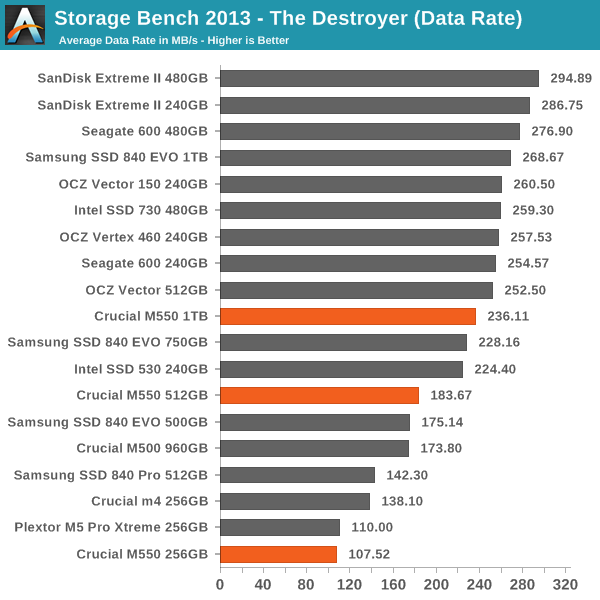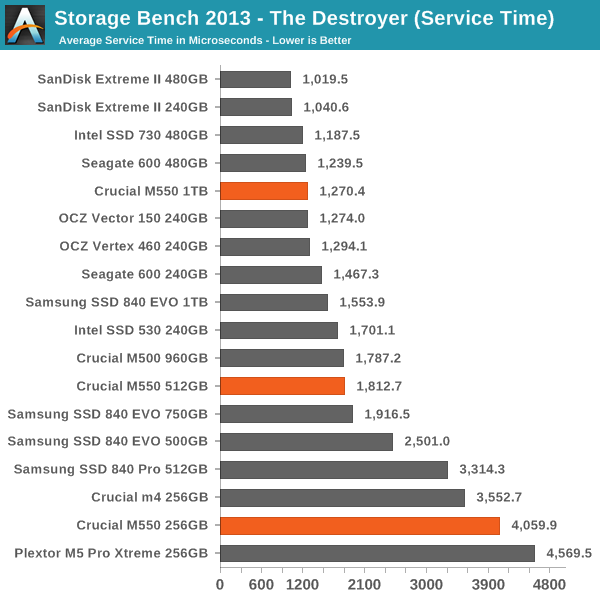Crucial M550 Review: 128GB, 256GB, 512GB and 1TB Models Tested
by Kristian Vättö on March 18, 2014 8:00 AM ESTAnandTech Storage Bench 2013
Our Storage Bench 2013 focuses on worst-case multitasking and IO consistency. Similar to our earlier Storage Benches, the test is still application trace based—we record all IO requests made to a test system and play them back on the drive we're testing and run statistical analysis on the drive's responses. There are 49.8 million IO operations in total with 1583.0GB of reads and 875.6GB of writes. As some of you have asked, I'm not including the full description of the test for better readability, so make sure to read our Storage Bench 2013 introduction for the full details.
| AnandTech Storage Bench 2013 - The Destroyer | ||
| Workload | Description | Applications Used |
| Photo Sync/Editing | Import images, edit, export | Adobe Photoshop CS6, Adobe Lightroom 4, Dropbox |
| Gaming | Download/install games, play games | Steam, Deus Ex, Skyrim, Starcraft 2, BioShock Infinite |
| Virtualization | Run/manage VM, use general apps inside VM | VirtualBox |
| General Productivity | Browse the web, manage local email, copy files, encrypt/decrypt files, backup system, download content, virus/malware scan | Chrome, IE10, Outlook, Windows 8, AxCrypt, uTorrent, AdAware |
| Video Playback | Copy and watch movies | Windows 8 |
| Application Development | Compile projects, check out code, download code samples | Visual Studio 2012 |
We are reporting two primary metrics with the Destroyer: average data rate in MB/s and average service time in microseconds. The former gives you an idea of the throughput of the drive during the time that it was running the test workload. This can be a very good indication of overall performance. What average data rate doesn't do a good job of is taking into account response time of very bursty (read: high queue depth) IO. By reporting average service time we heavily weigh latency for queued IOs. You'll note that this is a metric we've been reporting in our enterprise benchmarks for a while now. With the client tests maturing, the time was right for a little convergence.

The relatively poor IO consistency shows up in our Storage Bench 2013 as well. We are looking at about Samsung SSD 840 EVO level performance here (when taking the difference in over-provisioning into account), which is certainly a step up from the M500 but in the end the M550 is just a mediocre performer.











100 Comments
View All Comments
tech6 - Tuesday, March 18, 2014 - link
I don't think that the M550 is so much a "performance" variant as it is a direct replacement for the 500. Most likely what is happening here is that the benchmark for value SSDs has just been lifted slightly. Once the M500 disappears the 550 will assume its price point.Kristian Vättö - Tuesday, March 18, 2014 - link
The thing is, the M550 doesn't replace the M500. The M500 will continue to be available and the M550 is simply Crucial's "high-end" offering.ZeDestructor - Tuesday, March 18, 2014 - link
Interesting... Much like tech6, I was expecting the M500 to die off peacefully... Any details from micron on why they're doing that?For now, I should go and buy an M500 480GB already... They're really cheap...
Kristian Vättö - Tuesday, March 18, 2014 - link
There are still some cost savings from the 128Gbit NAND at the smaller capacities and it's possible that the controller/DRAM configurations are slightly cheaper as well. Could be that Crucial/Micron is also using slightly lower quality NAND for the M500 since the extra space reserved for RAIN makes sure that is not an issue.hojnikb - Tuesday, March 18, 2014 - link
Its interesting, that they are not using more dies per package (as opposed to samsung with evos).I'm guessing using less packages and possibly smaller pcb could yield additional cost savings for crucial/micron... Or is this not the case...? Also they could go with dramless like toshiba is doing with their q series ?
V500 anyone ?
hojnikb - Tuesday, March 18, 2014 - link
So basicly m500 is crucials/microns "low" end offering now.Just like the crappy v4 (that drive is really slow and im ashamed to own one) that was in the m4 days.
tim851 - Tuesday, March 18, 2014 - link
I hope so. I find the speed of SSDs to be sufficient for now and I'd like to see them work on pricing rather than performance.hojnikb - Tuesday, March 18, 2014 - link
Yeah i hope so too. I'm planning to buy 480GB/1TB version sometime this year to replace that sandforce joke i'm having now (intel's 330) and ditch HDDs alltogether.StevoLincolnite - Wednesday, March 19, 2014 - link
I'm running a several year old OCZ Vertex 2 64Gb SSD... Been solid.One thing I have never said however was: "Gee this SSD is slow!". - Mostly the main advantage SSD's brought to the arena was the stupidly low latencies compared to mechanical drives.
Price needs to still come down, capacities need to keep increasing in the low-end and mid-range segments.
Literally the single *biggest* upgrade that a majority of PC's could use is simply an SSD, regardless of it's transfer rates.
Even on ancient 6-7 year old Core 2 PC's...
trichome333 - Wednesday, March 19, 2014 - link
I agree mate. Just got a M500 240gb and I literally feel like a dunce for not moving earlier.